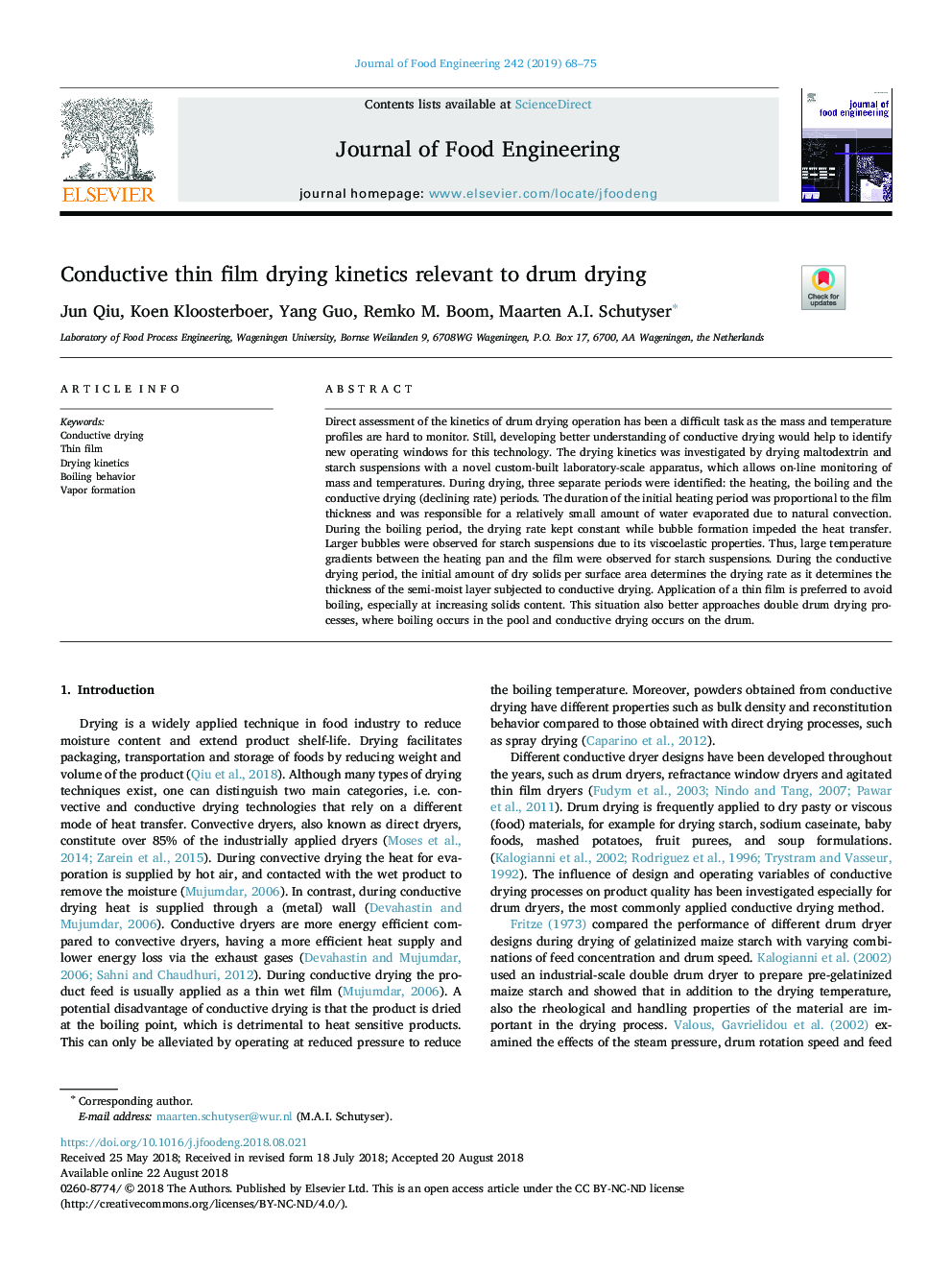| کد مقاله | کد نشریه | سال انتشار | مقاله انگلیسی | نسخه تمام متن |
|---|---|---|---|---|
| 10126824 | 1645002 | 2019 | 8 صفحه PDF | دانلود رایگان |
عنوان انگلیسی مقاله ISI
Conductive thin film drying kinetics relevant to drum drying
ترجمه فارسی عنوان
سینتیک خشک کردن فیلم نازک هدایت کننده مربوط به خشک کردن درام است
دانلود مقاله + سفارش ترجمه
دانلود مقاله ISI انگلیسی
رایگان برای ایرانیان
کلمات کلیدی
خشک کردن هدایت، فیلم نازک، سینتیک خشک کردن، رفتار جوش، تشکیل بخار،
ترجمه چکیده
ارزیابی مستقیم سینتیک عملیات خشک کردن درام یک کار دشواری است چرا که پروفیل های جرم و دما برای کنترل سخت است. با این حال، درک بهتر در مورد خشک کردن رسانایی، شناسایی پنجره های عامل جدید برای این تکنولوژی را کمک می کند. سینتیک خشک کردن با خشک کردن مالتودکسترین و نشریات تعلیق با یک دستگاه جدید مقیاس آزمایشگاهی جدید ساخته شده است که امکان نظارت بر جرم و دما را به صورت آنلاین فراهم می کند. در طی خشک کردن، سه دوره جداگانه شناسایی شد: گرمایش، جوش و خشک شدن رسانا (نرخ کاهش). طول مدت دوره گرمایش اولیه متناسب با ضخامت فیلم بود و منجر به کاهش نسبتا کم آب شده به دلیل انتقال حرارت طبیعی. در طول دوره جوش، میزان خشک شدن ثابت نگه داشته شد، در حالیکه شکل گیری حباب مانع انتقال حرارت شد. حباب های بزرگتر به علت خواص ویسکولا الاستیسیته به دلیل تعلیق نشاسته مشاهده شده است. بدین ترتیب، گرادیان درجه حرارت بالا بین پانل گرما و فیلم برای تعلیق نشاسته مشاهده شد. در طول دوره خشک کردن رسانا مقدار اولیه خشکی جامد در هر سطح، میزان خشک شدن را تعیین می کند، زیرا ضخامت لایه نیمه مرطوب تحت خشک شدن رسانایی را تعیین می کند. استفاده از یک فیلم نازک برای اجتناب از جوشاندن، به ویژه در افزایش محتوای جامد ترجیح داده می شود. این وضعیت همچنین فرآیندهای خشک کردن درام را بهتر می کند، جایی که جوش در استخر اتفاق می افتد و خشک شدن رسانا روی درام اتفاق می افتد.
موضوعات مرتبط
مهندسی و علوم پایه
مهندسی شیمی
مهندسی شیمی (عمومی)
چکیده انگلیسی
Direct assessment of the kinetics of drum drying operation has been a difficult task as the mass and temperature profiles are hard to monitor. Still, developing better understanding of conductive drying would help to identify new operating windows for this technology. The drying kinetics was investigated by drying maltodextrin and starch suspensions with a novel custom-built laboratory-scale apparatus, which allows on-line monitoring of mass and temperatures. During drying, three separate periods were identified: the heating, the boiling and the conductive drying (declining rate) periods. The duration of the initial heating period was proportional to the film thickness and was responsible for a relatively small amount of water evaporated due to natural convection. During the boiling period, the drying rate kept constant while bubble formation impeded the heat transfer. Larger bubbles were observed for starch suspensions due to its viscoelastic properties. Thus, large temperature gradients between the heating pan and the film were observed for starch suspensions. During the conductive drying period, the initial amount of dry solids per surface area determines the drying rate as it determines the thickness of the semi-moist layer subjected to conductive drying. Application of a thin film is preferred to avoid boiling, especially at increasing solids content. This situation also better approaches double drum drying processes, where boiling occurs in the pool and conductive drying occurs on the drum.
ناشر
Database: Elsevier - ScienceDirect (ساینس دایرکت)
Journal: Journal of Food Engineering - Volume 242, February 2019, Pages 68-75
Journal: Journal of Food Engineering - Volume 242, February 2019, Pages 68-75
نویسندگان
Jun Qiu, Koen Kloosterboer, Yang Guo, Remko M. Boom, Maarten A.I. Schutyser,
